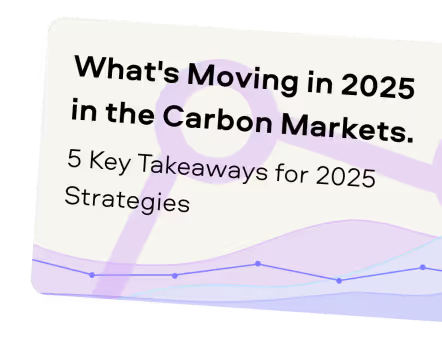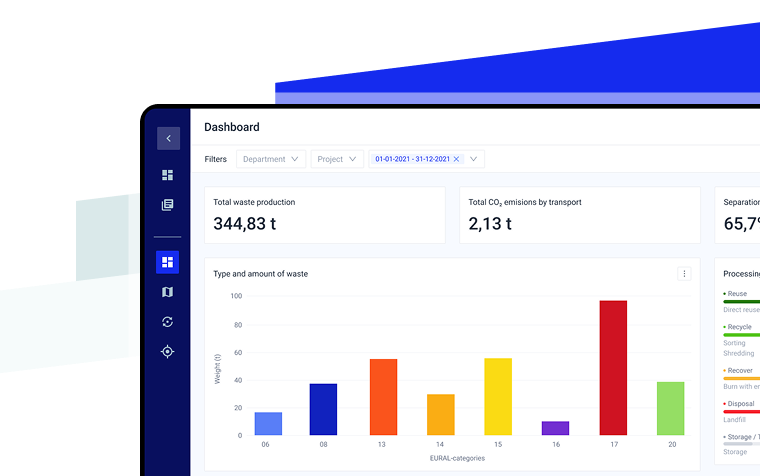“Over the years we’ve invested significantly in our field data team - focusing on producing trusted ratings. While this ensures the accuracy of our Ratings, it doesn’t allow the scale across the thousands of projects that buyers are considering.”
For more information on carbon credit procurement trends, read our "Key Takeaways for 2025" article. We share five, data-backed tips to improve your procurement strategy.

One more thing: Connect to Supply customers also get access to the rest of Sylvera's tools. That means you can easily see project ratings and evaluate an individual project's strengths, procure quality carbon credits, and even monitor project activity (particularly if you’ve invested at the pre-issuance stage.)
Book a free demo of Sylvera to see our platform's procurement and reporting features in action.
Why Artificial Intelligence Is a Priority for Waste Management
For years, enterprise waste management systems relied on spreadsheets, email attachments, and manual uploads from processors. With multiple sites, vendors, and waste materials (from municipal solid waste to hazardous streams), this approach is slow, error-prone, and nearly impossible to audit.
By 2025, new opportunities are emerging:
- Regulation as a catalyst: CSRD/ESRS E5 and ISO 14001 don’t just demand more detail—they give enterprises the chance to build audit-ready systems with real data lineage and traceability. Those who invest early turn compliance into a competitive advantage.
- Cost optimisation through visibility: Transport and processing fees fluctuate based on treatment type, distance, and market dynamics. AI waste management tools benchmark across processors and optimise collection routes, helping enterprises reduce € per tonne and environmental impact.
- More time for strategy: Studies show sustainability teams spend just 10% of their time on strategy, versus 40% on reporting and 25% on manual sorting and data validation. AI flips this ratio, freeing human workers to focus on reducing environmental pollution, recovering recyclable materials, and scaling the circular economy.
Integrating AI doesn’t just make compliance easier—it elevates data analysis and turns waste data into a lever for efficiency, resilience, and measurable carbon reductions. The case for AI is now clear, so let’s break down the most valuable AI and waste management use cases delivering tangible ROI for enterprises today.
10 Enterprise AI Use Cases That Actually Save Money (and CO₂)
#1 AI Data Ingestion and Standardisation (OCR + ML)
The problem: If you manage waste data across sites, you know the drill: piles of tickets, invoices, and manifests in different formats. Retyping, chasing missing fields, and double-checking totals eats hundreds of hours—and audits make it even worse.
The fix: geoFluxus’ Document AI reads documents automatically, extracts key fields, categorises waste materials and treatments, and fills gaps with machine learning. What took days of manual work is done in minutes.
Impact: The result is a 70–90% cut in time spent on data collection. Instead of being buried in admin, you can focus on what actually moves the needle. KPI: hours saved per reporting cycle.
#2 Anomaly Detection and Exception Handling
The problem: With thousands of records, errors slip through—misclassified waste, missing tickets, or sudden cost spikes. By the time you notice, it will be too late.
The fix: AI flags outliers instantly, from unusual volumes to suspicious invoices, and links them back to the source document for fast resolution.
Impact: Errors that once slipped through unnoticed—such as inflated invoices or misclassified waste—are flagged before they become audit findings or budget overruns. Teams can solve issues in hours, not weeks, avoiding costly surprises. KPI: € avoided through corrections.
#3 Routing Optimisation for Cost and CO₂
The problem: Waste often travels further than it should, with processors sending loads across borders. Every extra kilometre adds costs and CO₂, yet most enterprises never see this clearly.
The fix: Using waste collection route and vehicle data, AI highlights closer and better-performing processors. With geoFluxus, an interactive map shows all routes so you can spot unnecessary kilometres instantly. This is a practical example of waste management using AI to lower costs and emissions.
Impact: Clear route maps show when waste is travelling hundreds of unnecessary kilometres. By switching to closer processors, enterprises cut transport spend and reduce emissions from waste collection vehicles. KPI: Average km/waste stream; CO₂ from transport saved per year.
#4 Supplier Benchmarking and Circular Procurement
The problem: Waste contracts are long-term, but most procurement teams negotiate without a clear strategy. Processor invoices don’t show how vendors compare on recycling rates or transport distances. That leaves money on the table and limits circularity gains.
The fix: geoFluxus supplier benchmarking tools compare against industry averages, showing exactly where each processor stands on recycling outcomes and distances.
Impact: Instead of renegotiating unquestioningly, procurement can sit at the table with facts: benchmarks, recycling rates, and transport distances. This leverage translates into better pricing, stronger SLAs, and measurable improvements in circularity performance. KPI: €/tonne; % recycling uplift after renegotiation.
#5 Forecasting Waste Volumes and Capacity Planning
The problem: Waste volumes fluctuate, and when processors hit capacity, enterprises can face surcharges or be forced to ship loads overseas. Storing waste on-site isn’t an option, so unpredictable peaks quickly become costly and risky.
The fix: While still emerging, AI models are increasingly being used to analyse historical waste generation patterns. Over time, these models can forecast seasonal peaks or unexpected surges, including AI food waste management, where forecasting organic waste streams prevents costly overflows or missed composting opportunities.
Impact: By planning ahead, enterprises avoid costly last-minute shipments or processor refusals. Forecasts prevent waste from piling up onsite and ensure streams are treated in the most efficient and lowest carbon way possible. KPI: amount produced vs. amount forecasted waste.
#6 Critical Raw Material Recovery
The problem: Electronic waste, batteries, and industrial byproducts often contain critical raw materials, such as copper, cobalt, and rare earths. Without visibility, these valuable resources slip into disposal—raising costs and wasting potential revenue.
The fix: AI models scan EWC codes and stream descriptions to flag where critical raw materials are likely present, guiding recovery instead of disposal. This makes AI in e-waste management a powerful tool for recovering value.
Impact: Identifying rare earths in outflows turns what used to be disposal costs into new revenue streams. It also lowers reliance on virgin extraction, shrinking CO₂ footprints and supply chain risk. KPI: € recovered from secondary materials; tonnes of virgin resources avoided.
#7 Real-Time CO₂ Tracking by Stream
The problem: Most enterprises only see their carbon footprint once a year, in aggregated reports. This hides which waste streams drive the highest CO₂, making it hard to prioritise action.
The fix: AI links each waste load to verified emissions factors in real time, calculating CO₂ per stream, site, and treatment method.
Impact: Instead of waiting for annual sustainability reports, managers see emissions hotspots as they happen, thanks to these AI-driven waste management solutions. This means they can prioritise high-impact changes—like rerouting transport or shifting treatments—while proving reductions in real time to auditors and stakeholders. KPI: CO₂/tonne per stream; % emissions reduced vs baseline.
#8 CSRD and ESRS E5 Reporting Automation
The problem: Compliance eats up sustainability teams’ time. CSRD and ESRS E5 require site-level reporting with audit trails and data lineage. Doing this manually means endless spreadsheets and late nights before deadlines.
The fix: AI automates mapping of waste data to CSRD/ESRS fields, checking completeness and consistency along the way. Reports are generated audit-ready, aligned with ESRS E5 and geoFluxus circularity optimisation, with every datapoint linked to source evidence.
Impact: Teams no longer burn weeks assembling fragmented spreadsheets before audits. Reports are generated with complete lineage in hours, not months—removing late-night crunches and giving leaders confidence that every datapoint is defensible. KPI: Time-to-report reduction; number of audit issues flagged.
#9 IoT and Computer Vision Integration in Sorting
The problem: Sorting large volumes of waste is complex and often leads to material loss. In the waste management industry, processors are adopting smart imaging, computer vision, and AI-powered robots to separate recyclables more efficiently, while municipalities are testing smart waste bins to improve collection. Yet in most cases, this valuable data stays with processors and rarely makes its way back to enterprises.
The fix: Waste processors are already using IoT devices and computer vision to improve sorting, turning conveyor belt data into KPIs on recovery, contamination, and recycling efficiency. In the future, enterprises can connect these outputs directly to their dashboards for transparent reporting, optimized by innovative waste management solutions that utilize AI to enhance sorting accuracy.
Impact: Instead of relying on processor claims, enterprises see precisely how much contamination and recovery happen on the sorting line. KPI: Separation rate; % recyclables correctly recovered.
#10 Natural Language Queries on Verified Waste Data
The problem: Managers waste hours digging through spreadsheets just to answer simple questions: How much waste did we generate this quarter? Which site has the highest landfill rate?
The fix: With large language model (LLM) assistants layered over verified datasets, managers can query waste data in plain language and get instant, audit-ready answers.
Impact: Managers get instant answers to operational questions—speeding up decisions and removing bottlenecks from site managers to executives. The result: less time wasted on manual analysis and more focus on action. KPI: Average time-to-insight; % reduction in decision cycle time.
Implementation Roadmap (30/60/90 Days)
With so many practical applications, enterprises often ask the same question: where do we start? That’s why we’ve built a clear 30/60/90-day roadmap.
0–30 Days: Establish Your Baseline
- Audit current data sources (tickets, invoices, manifests) and identify where AI-based waste management gaps exist.
- Deploy AI Data Ingestion (#1) at one or two pilot sites to replace manual retyping.
- Define the KPIs that matter most, for example: waste generated per site, recycling rate, incineration & landfill rate, CO₂ per tonne, and kilometres travelled.
- Consolidate datasets and prepare for Anomaly Detection (#2) by creating a single source of truth.
31–60 Days: Build the Foundation
- Configure Anomaly Detection (#2) alerts to flag missing tickets, misclassifications, or unusual volumes.
- Launch dashboards to support analysis, Routing Optimisation (#3), and Supplier Benchmarking (#4)—so teams see transport kilometres, processor performance, and recycling outcomes in real time.
- Begin Forecasting (#5) with historical waste generation patterns to anticipate seasonal peaks and capacity risks.
61–90 Days: Optimise and Scale
- Apply verified data for Critical Raw Material Recovery (#6), identifying valuable streams such as e-waste or metals.
- Enable Real-Time CO₂ Tracking (#7) to link every load to emissions factors.
- Produce your first CSRD/ESRS report (#8) with full audit trails and lineage.
- Request additional insights from processors—some might be able to generate sorting or contamination data that can plug into your system (#9).
- Roll out Natural Language Queries (#10) so managers can answer questions instantly, without waiting for static reports.
Overwhelmed about where to start? With geoFluxus data automation and verification, the heavy lifting is already done. Our AI-powered platform features built-in ingestion, verification, reporting, and dashboards. All you need to do is upload your waste data—tickets, invoices, or PDFs—and within days you’ll have audit-ready reports, optimisation insights, and measurable CO₂ savings.
Build vs. Buy — What Enterprises Should Consider
Of course, implementing AI isn’t just about timelines. Another critical decision is whether to build in-house tools or adopt ready-to-use AI-powered waste management platforms.
Building in-house AI for waste management may sound attractive, but most enterprises underestimate the complexity. Waste data isn’t like financial data—you’re dealing with messy invoices, processor portals, and dozens of treatment codes. Without specialised expertise, it’s almost impossible to separate real insights (e.g. a processor underperforming) from simple data errors.
The Risks of Building In-House
- Compliance risk: Regulators expect traceable audit trails across all sites. Homegrown tools often crumble under audit scrutiny.
- Speed-to-value: A pilot might work in one plant, but scaling across 20+ sites and vendors takes years—not months.
- Total cost of ownership: Beyond software, you’ll need continuous data cleansing, regulatory updates, and support staff.
- Security & scalability: Waste data touches contracts, costs, and compliance. Lineage, role-based access, and cross-site scalability are non-negotiable.
- Knowledge gap: Knowing which anomalies matter, how to group waste streams correctly, or which KPIs actually drive savings requires deep waste-sector expertise. Without it, in-house tools risk producing data that looks “clean” but is misleading or unusable.
The Advantage of Buying Ready-to-Use AI
With geoFluxus, both the infrastructure and expertise are built in. Document AI, anomaly detection, benchmarking, and CSRD-ready reporting have been trained on real waste datasets across industries. That means you’re not just buying software—you’re buying years of embedded knowledge on what to track, how to structure it, and how to make it defensible under audit.
Checklist for Any AI Waste Management System
Before you choose build or buy, ensure your solution has:
- Verified ingestion (OCR + APIs) that handles tickets, invoices, and manifests
- AI algorithms with built-in anomaly detection and exception handling
- Audit-ready reporting templates
- Procurement benchmarking tools for smarter vendor contracts
- Multi-site scalability with role-based access and strong security
- Embedded expertise on material groupings, processing requirements, and circularity KPIs
Whether you build or buy, one fact is apparent: AI is already reshaping how waste is managed. The enterprises that act now will be the ones setting industry benchmarks by 2030.
Conclusion
Between now and 2030, enterprises that embrace waste management AI will have a clear edge. Verified data combined with automation unlocks faster reporting, stronger audits, and smarter operational decisions—from cutting kilometres travelled to recovering valuable materials.
geoFluxus provides the backbone for automation, compliance, and circular performance through a verified waste management system, using AI for documentation, anomaly detection, benchmarking dashboards, and CSRD-ready reporting templates. With everything integrated, you don’t need to build complex systems from scratch—you just upload your data, and the platform delivers insights that cut costs and emissions.
Ready to future-proof your waste reporting with AI? Book a geoFluxus demo and see how verified data can unlock compliance, circularity, and measurable CO₂ reductions.
FAQs
How is AI used in waste management?
AI systems for enterprises looking to analyse their waste management performance can integrate scattered datasets, extract information from documents, detect anomalies, and generate insights that cut costs, improve recycling rates, and lower greenhouse gas emissions. On the waste processor side, recent years have seen the rise of AI technologies such as computer vision, AI-powered robots, and smart bins—pivotal tools in recycling facilities and waste collection systems that optimise waste sorting and reduce environmental impact. That’s why AI and waste management have become inseparable.
What data do we need to start?
Tickets, invoices, manifests, and transport logs from all waste management companies and sites. These provide the backbone for predictive analytics and real-time data reporting.
Does AI replace manual reporting?
AI drastically reduces human error and the need for manual sorting in reporting, but it doesn’t remove accountability. Teams still need to validate assumptions, define the right KPIs, and make informed operational decisions. What AI does is accelerate the process—turning days of manual work into minutes of verified insights.
What are critical raw materials in waste?
Critical raw materials (CRMs) are essential resources—such as lithium, cobalt, rare earths, gallium, and tantalum—used in electronics, batteries, wind turbines, and solar panels. In waste, CRMs are found in e-waste, batteries, and industrial by-products. Identifying them allows enterprises to recover valuable resources, recycle waste items, and reduce reliance on virgin materials.
How does geoFluxus integrate with existing systems?
Through APIs, OCR, and AI technologies, which ingest processor documents, ERP exports, and IoT outputs into a single, verified dataset—ready for dashboards, audits, and reporting.









